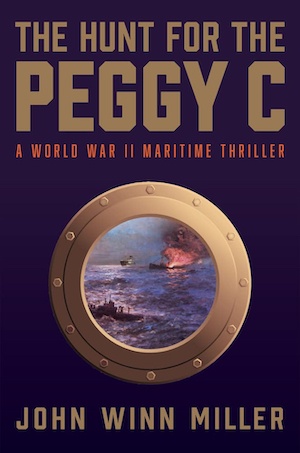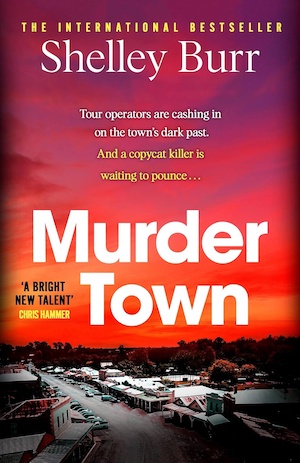
The tumult of World War II is an endless source of inspiration for crime fiction and historical authors, but it takes a lot of dedication to craft a story that not only feels true to the era but gets readers to engage with the characters and the things they represent. That’s where the effort has been focused in The Hunt for the Peggy C, a maritime thriller and debut novel for John Winn Miller.
Miller is no stranger to writing. He’s a veteran journalist who has worked in the US and Europe. He’s also written scripts and been involved in four film productions. All of that experience has gone into The Hunt for Peggy C, and then some. A native of Lexington, Kentucky, he had very little nautical background, and spent years researching his story before having it published. Just the tale of how the book came to be is a fascinating one. Below, we talk to the author, as well as bringing you a excerpt from the novel to enjoy.
It’s got battle action, suspense, brutality and love story. Are you ready? Sound the foghorn…
What will crime fiction lovers love about The Hunt for Peggy C?
This is not your usual World War II maritime thriller. It is the tale of a 3,000-mile chase through naval and aerial battles involving pirates, smugglers, a mutinous crew of a rusty tramp steamer captained by an American fugitive, a drug-addled U-boat captain, a Jewish heroine, and even murder.
What goes on aboard the ship that ramps up the tension?
The captain of the Peggy C, Jake Rogers, rescues a Jewish family from Amsterdam, infuriating his cargo ship’s crew of misfits and triggering a deadly game of cat-and-mouse with a deranged U-boat captain bent on revenge. Along the way, the cynical Rogers falls in love with the family’s eldest daughter and realises it is better to do the right thing, even if it isn’t the safest thing.
And where did the inspiration to write the book come from?
Believe it or not, it came from a dream I had after watching one more lousy movie and thinking I could write a better script. When I woke up the following day, I knew the first and last scenes and the ship’s name. That was all. I had to spend years researching to fill in the blanks.

Where did the inspiration for the key characters come from?
The idea for Captain Jake Rogers was sparked by stories my father told of being kicked out of military school for beating up upperclassmen who were picking on him and other plebes. Then I discovered that James Fenimore Cooper was kicked out of the Naval Academy and went on to become a merchant marine before writing America’s first novel, The Pilot. So, I wanted a tough hero without a country who is a voracious reader and who uses his brains more than his considerable brawn to get out of tough situations. The antagonist, Oberleutnant zur See Viktor Brauer, is based on several real U-boat captains, good and evil. I frankly don’t know where the Jewish heroine Miriam Maduro came from. She just showed up and took over the whole story.
Which is your favourite and why?
Miriam Maduro, the eldest daughter of the rescued Jewish family, is my favourite character. She is a sweet medical student with a militant streak who suffered greatly at the hands of the occupying Nazis. Rogers gradually falls in love with her and the whole family. When Rogers is seriously wounded, Miriam has to prove she is as tough as her rhetoric to save everyone from Brauer and his U-boat crew.
What research did you carry out to make the story and life on the vessel feel authentic?
I had never been on a U-boat or tramp steamer and knew next to nothing about the sea. And I am not Jewish, although I have Ashkenazi blood. So, I had to read tons of books, magazine and newspaper articles, watch documentaries, search online archives, and discover amazingly informative websites like www.uboat.net. I even went so far as to read the wartime logs of U-boat captains to accurately describe the moon’s phases during each leg of the chase. I was also fact-checked by a Jewish cousin, naval officers, a PhD student at the War Studies Department at King’s College in London, and readers of early drafts. So, the history and technology are real. The story is mine.
How did your background in journalism, as a producer and as a screenwriter inform how you tackled the material and the story?
In over 30 years as an investigative reporter, foreign correspondent and editor, I learned how to write clearly and how to become an expert quickly on just about any subject. Scriptwriting taught me how to write compelling visuals and how to structure a drama that would keep the audience on the edge of their seats. But, like producing movies, I had to pull all those skills together to write a novel that used all five senses, had interesting character arcs, and an ending that famed screenwriter William Goldman said doesn’t have to make you feel good; it just has to make you feel. “The secret to an ending is to give the audience what they want,” Goldman wrote, “but not the way they expect it.”
There are some tough depictions of life in The Netherlands under the Nazis. What were these like to write?
Heartbreaking. To be accurate, I had to re-live the horrors of their daily lives through books, diaries and documentaries as things got progressively worse. They were banned from parks, forced to register and carry papers with J for Jew, kicked out of schools and government jobs, forbidden to shop in most stores, and constantly harassed and beaten by Dutch fascists. As Miriam told Jake, “You cannot understand the dread, walking around every day afraid, everyday getting hungrier, more humiliated, hopeless.” She also described how she and her young cousin Wim were beaten during a protest march by fascist thugs, including a gentile they had grown up with named Luuk. “The last thing I remember was Luuk’s face, smiling and laughing with his friends, Wim’s blood and my blood on his hands.”
You’ve also hidden some Easter eggs in there for history buffs. Can you give us one or two clues about what to look for?
I thought I knew a lot about World War II because I had devoured books about it since I was young. But almost every day, as I did more research, I came across something that would make me exclaim, “Wait. What? I had no idea about that.” Here are just two of the gems that play critical parts in my story:
- After the Royal Air Force won the three-month-long Battle of Britain in 1940, Air Chief Marshal Arthur Tedder publicly said three things led to victory: the bravery and skill of the pilots, the Rolls Royce-made engines, and… you’ll have to read The Hunt for the Peggy C to learn how the third reason adds a big bang to the plot.
- Hitler had pirates? Yes, he did. And they were the bane of merchant ships, armed or not, on the Seven Seas, collectively sinking or capturing 140 ships totaling close to a million tons. You’ll never guess that British First Lord of the Admiralty first came up with the idea.
What’s next for John Winn Miller?
I stunned myself when I immediately started writing a sequel after selling The Hunt for the Peggy C to Bancroft Press. I was even more stunned when I finished it and began the third volume with many of the same characters in different phases of World War II. I never intended to do more than one novel. But my publisher, Bruce Bortz, said I should keep writing, and I did. I am also trying to sell a TV pilot that my brother Harry B Miller III, a film editor, writer-director John Harrison, and I wrote. You could say I’m staying busy.
The Hunt for the Peggy C (excerpt)
By John Winn Miller
*Words in parentheses were added for clarity
(U-boat Captain) Brauer popped a Pervitin into his mouth as he, (First Watch Officer) Tauber, and four lookouts – all with red swollen eyes from the frozen ocean spray – scanned the foggy horizon from the bridge atop the conning tower. Heavy rain mixed with hail pounded their oilskin foul weather gear, nicknamed “derGrosse Seehund” or “The Big Seal.” Gale-force winds tore at their floppy sou’wester rain hats with the distinctive long flap covering their necks and fastened under their chins.
Tauber, the habitual Jan Maat cigarette hanging from his mouth, chopped his arm at the horizon, “Shadow off the port beam.” Brauer pressed the binoculars to his eyes and spotted a distant ship, a fully-rigged three-mast schooner blindly tacking in turbulent waters on a near collision course with the U-boat.
“What a magnificent sight, eh, Herr Oberleutnant,” Tauber said, tugging his wide leather safety belt to make sure it was secure as another towering wave swamped the bridge. The white, wooden ship’s three masts soared majestically and had twelve fore- and aft-rigged sails plus two square sails on the foremast. It flew a Swedish flag. Tauber moved his binoculars in another direction.
“What are you doing, First Watch Officer?” Brauer asked.
“Looking for a target, sir.”
“We have a cargo ship right in front of us. Loaded with contraband, no doubt.”
“Should I order a boarding party?”
“Not necessary.”
“Sir, the Prize Regulations say we should warn her first—”
“Might be a U-Bootfalle setting a trap,” Brauer said, referring to British armed Q-ships disguised as merchant vessels that ambushed and sank at least fifteen U-boats during World War I, an idea credited to then-First Lord of the Admiralty Winston Churchill that was revived by now Prime Minister Churchill. “The British also have been arming their merchant ships. One even attacked my first submarine while we were trying to rescue their very own sailors. The hypocrites: they have set the rules, and now they’ll have to live by them. As far as I’m concerned, it is unrestricted submarine warfare.”
Brauer lowered his binoculars and mulled his next move. He knew the British Admiralty had taken command of all British merchant ships in 1939, and had been arming thousands of them with low-angle four-inch guns and three-inch anti-aircraft guns. The weapons on the Defensively Equipped Merchant Ships, known as DEMS, were manned by the Royal Navy with assistance from trained crew members. What worried Brauer was he didn’t know how many of the merchants had been armed up to date.
“I’m not taking any chances,” Brauer said. “But I’m not going to waste a torpedo on it, either. Get the gun crew up here.”
“But sir, it’s hardly worth—”
“They need the practice,” Brauer said, the veins in his neck popping out.
The order of “clear for guns” was shouted along. Three sailors – gunner, layer and loader – and Second Watch Officer Wolfgang Mueller, all wearing life jackets, rushed up through the hatch. They scampered down metal rungs on both sides of the conning tower onto the upper deck’s slippery wooden slats and waited, holding tight to a metal rail, carefully timing their next move. When the bow rose on a cresting wave, pulling the deck momentarily above the waterline, they dashed to their 8.8-cm gun and buckled on safety lifelines just before towering walls of water crashed over their heads, blinding and choking them. Inside the ship, crew members unloaded ammunition from the magazines beneath the decking next to the captain’s cabin, and unpacked the shells from their individual metal containers. Others formed a line and carefully relayed the thirty-three-pound brass shells hand-to-hand from the control room up through the conning tower hatch and down from the bridge through a small chute at the front to the deck. There it was held in readiness for the loaders.
“It is unarmed, sir,” Tauber said.
“Hold until she’s closer,” Brauer said, ignoring Tauber and making a mental note to write him up for incompetence, insubordination and, worst of all for a submariner, weakness. Brauer knew this type of motorized schooner well from his early days of naval training on the much larger Gorch Fock in the Baltic Sea. She appeared to be 120-140 feet in length, which meant she was capable of holding more than 125 tons in cargo. It wasn’t much of a target, but he was itching for a kill to erase the stain of the last few disastrous days.
Gunnery Officer Peter Radke used a megaphone in the howling wind to relay commands from Brauer down to Mueller and the gun crew.
“Target 500 meters, course 260, speed seven,” Tauber said, taking readings from the firing binoculars mounted over a gyrocompass repeater that showed true north, which unlike regular compasses was unaffected by the magnetic pull of the metal ship.
Men rushed around the schooner’s deck, waving their arms and shouting.
“Open fire!” Brauer shouted.
Before Radke could repeat the command, a mammoth wave swept over the conning tower, knocking all the watch crew members off their feet, and drenching the men in the control room below the hatch. As Brauer helped Radke up, one of the other lookouts held his bloody mouth and screamed, “My teeth! My teeth are gone!”
The captain examined the wounded sailor’s mouth before helping him down the hatch. “Get the pharmacist mate! This man needs attention,” he shouted into the ship. There were no doctors on U-boats. Medical emergencies were handled by a lightly trained pharmacist mate, typically one of the radio operators because their work required oil-free and relatively clean hands, or sometimes by the captains, who took a medical course as part of their training. Brauer struggled to his feet and was about to repeat his order to fire when he noticed there were only two gunners on the deck with Mueller; one of the gunners, washed overboard on the starboard side, was hanging suspended over the saddle tank, one of two external ballast tanks that looked like elongated saddlebags.
“Open fire!” Brauer screamed at the gun crew as they scrambled to reel in their fallen comrade by his lifeline. The schooner was dangerously close, crashing up and down over the soaring waves, picking up speed. Brauer grabbed the megaphone from Radke. “Leave him and open fire, now!”
For all of the action in The Hunt for the Peggy C, order a copy using the button below…




